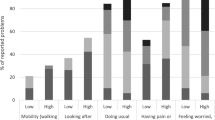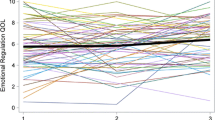Abstract
Purpose
To examine the longitudinal construct validity in the assessment of changes in depressive symptoms of widely used utility and generic HRQL instruments in teens.
Methods
392 teens enrolled in the study and completed HRQL and diagnostic measures as part of the baseline interview. HRQL measures included EuroQol (EQ-5D-3L), Health Utilities Index Mark 2 (HUI2) and Mark 3 (HUI3), Quality of Well-Being Scale (QWB), Pediatric Quality of Life Inventory (PEDS-QL), RAND-36 (SF-6D), and Quality of Life in Depression Scale (QLDS). Youth completed follow-up interviews 12 weeks after baseline. Sixteen youth (4.1%) were lost to follow-up. We examined correlations between changes in HRQL instruments and the Children’s Depression Rating Scale-Revised (CDRS-R) and assessed clinically meaningful change in multi-attribute utility HRQL measures using mean change (MC) and standardized response mean (SRM) among youth showing at least moderate (20%) improvement in depression symptomology.
Results
Spearman’s correlation coefficients demonstrated moderate correlation between changes in CDRS-R and the HUI2 (r = 0.38), HUI3 (r = 0.42), EQ-5D-3L (r = 0.36), SF-6D (r = 0.39), and PEDS-QL (r = 0.39) and strong correlation between changes in CDRS-R and QWB (r = 0.52) and QLDS (r = − 0.71). Effect size results are also reported. Among multi-attribute utility measures, all showed clinically meaningful improvements in the sample of youth with depression improvement (HUI2, MC = 0.20, SRM = 0.97; HUI3, MC = 0.32, SRM = 1.17; EQ-5D-3L, MC = 0.08, SRM = 0.51; QWB, MC = 0.11, SRM = 0.86; and SF-6D, MC = 0.12, SRM = 1.02).
Conclusions
Findings support the longitudinal construct validity of included HRQL instruments for the assessment of change in depression outcomes in teens. Results of this study can help inform researchers about viable instruments to include in economic evaluations for this population.
Similar content being viewed by others
References
Brent, D. A., & Weersing, V. R. (2008). Depressive disorders in childhood and adolescence. In M. Rutter, et al. (Eds.), Rutter’s child and adolescent psychiatry. Oxford: Blackwell Publishing Ltd. pp. 587–613.
Lynch, F. L., & Clarke, G. N. (2006). Estimating the economic burden of depression in children and adolescents. American Journal of Preventive Medicine, 31(6 Suppl 1), S143-51.
Smith, J. P., & Smith, G. C. (2010). Long-term economic costs of psychological problems during childhood. Social Science and Medicine (1982), 71(1), pp. 110–115.
Tunis, S. R., Stryer, D. B., & Clancy, C. M. (2003). Practical clinical trials: Increasing the value of clinical research for decision making in clinical and health policy. JAMA, 290(12), 1624–1632.
Gold, M. R., et al. (1996). Cost-effectiveness in health and medicine. New York: Oxford Univeristy Press.
Drummond, M. (2001). Introducing economic and quality of life measurements into clinical studies. Annals of Medicine, 33(5), 344–349.
Clarke, G. et al., (2016). Cognitive behavioral therapy in primary care for youth declining antidepressants: A randomized trial. Pediatrics. 137(5).
Emslie, G. J., Weinberg, W. A., & Mayes, T. L. (1998). Treatment of children with antidepressants: Focus on selective serotonin reuptake inhibitors. Depression and Anxiety, 8(Suppl1), 13–17.
Hansen, R. et al. (2008). Meta-analysis of major depressive disorder relapse and recurrence with second-generation antidepressants. Psychiatric Services (Washington, D. C.), 59(10), 1121–1130.
Jellinek, M. S., & Snyder, J. B. (1998). Depression and suicide in children and adolescents. Pediatrics in Review/American Academy of Pediatrics, 19(8), 255–264.
Brazier, J., et al. (2014). A systematic review, psychometric analysis and qualitative assessment of generic preference-based measures of health in mental health populations and the estimation of mapping functions from widely used specific measures. Health Technology Assessment Health Technol Assess (Rockv) Health Technology Assessment (Winchester, England), 18(34), vii–viii, xiii–xxv, 1–188.
Gunther, O. H., et al. (2008). The responsiveness of EQ-5D utility scores in patients with depression: A comparison with instruments measuring quality of life, psychopathology and social functioning. Journal of Affective Disorders, 105(1–3), 81–91.
Byford, S. (2013). The validity and responsiveness of the EQ-5D measure of health-related quality of life in an adolescent population with persistent major depression. Journal of Mental Health (Abingdon, England), 22(2), 101–110.
Lynch, F. L., et al. (2016). Measuring health-related quality of life in teens with and without depression. Medical Care, 54(12), 1089–1097.
Brent, D., et al. (2008). Switching to another SSRI or to venlafaxine with or without cognitive behavioral therapy for adolescents with SSRI-resistant depression: The TORDIA randomized controlled trial. JAMA, 299(8), 901–913.
March, J. S., et al. (2007). The treatment for adolescents with depression study (TADS): Long-term effectiveness and safety outcomes. Archives of General Psychiatry, 64(10), 1132–1143.
Clarke, G., et al. (2005). A randomized effectiveness trial of brief cognitive-behavioral therapy for depressed adolescents receiving antidepressant medication. Journal of the American Academy of Child and Adolescent Psychiatry, 44(9), 888–898.
Kaufman, J., et al. (1997). Schedule for Affective disorders and schizophrenia for school-age children-present and lifetime version (K-SADS-PL): Initial reliability and validity data. Journal of the American Academy of Child and Adolescent Psychiatry, 36(7), 980–988.
Poznanski, E. O., et al. (1984). Preliminary studies of the reliability and validity of the children’s depression rating scale. Journal of the American Academy of Child Psychiatry, 23(2), 191–197.
Mayes, T. L., et al. (2010). Psychometric properties of the children’s depression rating scale-revised in adolescents. Journal of Child and Adolescent Psychopharmacology, 20(6), 513–516.
De Civita, M., et al. (2005). Evaluating health-related quality-of-life studies in paediatric populations: Some conceptual, methodological and developmental considerations and recent applications. PharmacoEconomics, 23(7), 659–685.
Feeny, D., et al. (2004). Comparing directly measured standard gamble scores to HUI2 and HUI3 utility scores: Group-and individual-level comparisons. Social Science and Medicine (1982), 58(4), 799–809.
Feeny, D., et al. (2002). Multiattribute and single-attribute utility functions for the health utilities index mark 3 system. Medical Care, 40(2), 113–128.
Furlong, W. J., et al. (2001). The Health Utilities Index (HUI) system for assessing health-related quality of life in clinical studies. Annals of Medicine, 33(5), 375–384.
Torrance, G. W., et al. (1996). Multiattribute utility function for a comprehensive health status classification system. Health Utilities Index Mark 2. Medical Care, 34(7), 702–722.
Essink-Bot, M. L., Stouthard, M. E., & Bonsel, G. J. (1993). Generalizability of valuations on health states collected with the EuroQolc-questionnaire. Health Economics, 2(3), 237–246.
Kaplan, R. M. (2003). The significance of quality of life in health care. Quality of Life Research: An International Journal of Quality of Life Aspects of Treatment, Care and Rehabilitation, 12(Suppl 1), 3–16.
Brazier, J., Roberts, J., & Deverill, M. (2002). The estimation of a preference-based measure of health from the SF-36. Journal of Health Economics, 21(2), 271–292.
Hays, R. D., & Morales, L. S. (2001). The RAND-36 measure of health-related quality of life. Annals of Medicine, 33(5), 350–357.
Varni, J. W., Seid, M., & Kurtin, P. S. (2001). PedsQL 4.0: Reliability and validity of the pediatric quality of life inventory version 4.0 generic core scales in healthy and patient populations. Medical Care, 39(8), 800–812.
Donald Sherbourne, C., et al. (2001). Can utility-weighted health-related quality-of-life estimates capture health effects of quality improvement for depression? Medical Care, 39(11), 1246–1259.
Hunt, S. M., & McKenna, S. P. (1992). The QLDS: a scale for the measurement of quality of life in depression. Health Policy (Amsterdam, Netherlands), 22(3), 307–319.
Guyatt, G. H., et al. (1987). A measure of quality of life for clinical trials in chronic lung disease. Thorax, 42(10), 773–778.
Grootendorst, P., Feeny, D., & Furlong, W. (2000). Health Utilities Index Mark 3: Evidence of construct validity for stroke and arthritis in a population health survey. Medical Care, 38(3), 290–299.
Horsman, J., et al. (2003). The Health Utilities Index (HUI): Concepts, measurement properties and applications. Health and Quality of Life Outcomes, 1, 54.
Walters, S. J., & Brazier, J. E. (2003). What is the relationship between the minimally important difference and health state utility values? The case of the SF-6D. Health and Quality of Life Outcomes, 1, 4.
Walters, S. J., & Brazier, J. E. (2005). Comparison of the minimally important difference for two health state utility measures: EQ-5D and SF-6D. Quality of Life Research: An International Journal of Quality of Life Aspects of Treatment, Care and Rehabilitation, 14(6), 1523–1532.
Feeny, D., et al. (2005). A cohort study found the RAND-12 and Health Utilities Index Mark 3 demonstrated construct validity in high-risk primary care patients. Journal of Clinical Epidemiology, 58(2), 138–141.
Marra, C. A., et al. (2005). A comparison of generic, indirect utility measures (the HUI2, HUI3, SF-6D, and the EQ-5D) and disease-specific instruments (the RAQoL and the HAQ) in rheumatoid arthritis. Social Science and Medicine (1982), 60(7), 1571–1582.
Cohen, J. (1988). Statistical power analysis for the behavioral sciences (2nd edn.). New Jersey: Lawrence Erlbaum Associates.
Pyne, J. M., et al. (2003). Use of the quality of well-being self-administered version (QWB-SA) in assessing health-related quality of life in depressed patients. Journal of Affective Disorders, 76(1–3), 237–247.
Sapin, C., et al. (2004). Usefulness of EQ-5D in assessing health status in primary care patients with major depressive disorder. Health and Quality of Life Outcomes, 2, 20.
Wiebe, S., et al. (2003). Comparative responsiveness of generic and specific quality-of-life instruments. Journal of Clinical Epidemiology, 56(1), 52–60.
Turner, N., et al. (2013). A comparison of four different approaches to measuring health utility in depressed patients. Health and Quality of Life Outcomes, 11, 81.
http://factfinder.census.gov. Accessed 1 Sep 2016.
Wille, N., et al. (2010). Development of the EQ-5D-Y: A child-friendly version of the EQ-5D. Quality of Life Research: An International Journal of Quality of Life Aspects of Treatment, Care and Rehabilitation, 19(6), 875–886.
Mihalopoulos, C., et al. (2014). Assessing outcomes for cost-utility analysis in depression: Comparison of five multi-attribute utility instruments with two depression-specific outcome measures. The British Journal of Psychiatry: The Journal of Mental Science, 205(5), 390–397.
Acknowledgements
We thank Jill Pope for editorial support, and Allison Bonifay, Sue Leung, and Jeff Jensen for management and conduct of participant interviews.
Funding
The funding was provided by Agency for Healthcare Research and Quality (Grant No. R01-HS017720).
Author information
Authors and Affiliations
Corresponding author
Ethics declarations
Conflict of interest
It should be noted that David H. Feeny has a proprietary interest in Health Utilities Incorporated, Dundas, Ontario, Canada. HUI Inc. Distributes copyrighted Health Utilities Index (HUI) materials and provides methodological advice on the use of the HUI. No other authors have any conflicts of interest.
Ethical approval
All procedures performed in studies involving human participants were in accordance with the ethical standards of the institutional and/or national research committee and with the 1964 Helsinki declaration and its later amendments or comparable ethical standards.
Rights and permissions
About this article
Cite this article
Dickerson, J.F., Feeny, D.H., Clarke, G.N. et al. Evidence on the longitudinal construct validity of major generic and utility measures of health-related quality of life in teens with depression. Qual Life Res 27, 447–454 (2018). https://doi.org/10.1007/s11136-017-1728-9
Accepted:
Published:
Issue Date:
DOI: https://doi.org/10.1007/s11136-017-1728-9




